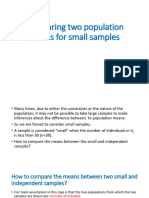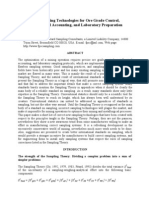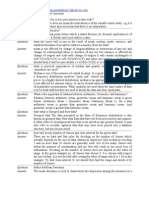Learning Objectives: Two Sample T-Test
Uploaded by
JinzhuZhaiLearning Objectives: Two Sample T-Test
Uploaded by
JinzhuZhaiLearning Objectives
1. Distinguish dependent v.s. independent samples
2. With sample data from two independent samples,
a) Test hypotheses made about two population means.
b) Construct confidence interval estimates of the
difference between two population means.
Two sample t-test
3. With sample data from dependent samples,
a) Test hypotheses
b) Construct confidence interval estimates
Paired t-test
Textbook: Section 1.10
Independent or Dependent Samples?
Here are four descriptions of research studies.
a) Subjects were tested for their sense of smell twice: once
when lying down, once wile sitting up. Researchers want
to know whether the mean ability to detect smells differs
depending on whether one is sitting up or lying down.
b) Men and women each had their sense of smell measured.
Researchers want to know whether, typically, men and
women differ in their ability to sense smells.
c) Researchers randomly assigned overweight people to one
of two diets: Weight Watchers and Atkins. Researchers
want to know whether the mean weight loss on Weight
Watchers was different from that on Atkins.
d) The numbers of years of education for husbands and
wives are compared to see whether the means are
different.
Assumptions for Two sample t-test: The two samples are
independent.
Case I: Large sample sizes
That is, n
1
30 and n
2
30.
Case 2: Small sample sizes
Need an additional assumption:
a) Both population distributions are normal
b) =
Case 3: Small sample sizes with normal populations and
2
1
o
2
2
o
2
1
o
2
2
o
Notation for Independent Samples
1
2
= difference between
means
- = Point Estimate of
1
2
Population 1
1
= population mean
= population
variance
Population 2
2
=population mean
= population
variance
Sample 2
n
2
= sample size
= sample mean
s
2
= sample standard
deviation
Sample 1
n
1
=sample size
= sample mean
s
1
= sample standard
deviation
2
1
o
2
2
o
1
x
2
x
1
x
2
x
Expected Value
Sampling Distribution of
Standard Deviation (Standard Error)
2 1
x x
2 1 2 1
) ( = x x E
2
2
2
1
2
1
2 1
n n
x x
o o
o + =
Hypothesis Tests About
1
2
:
independent and large samples
Hypotheses
=
1 2 0
:
a
H D
=
0 1 2 0
: H D s
0 1 2 0
: H D
>
1 2 0
:
a
H D
>
0 1 2 0
: H D
<
1 2 0
:
a
H D
Left-tailed Right-tailed Two-tailed
Test Statistic
1 2 1 2
2 2
1 2
1 2
( ) ( ) x x
z
n n
o o
=
+
If population variances are unknown, we replace
them with sample variances.
Example: Par, Inc.
In a test of driving distance using a mechanical
driving device, a sample of Par golf balls was
compared with a sample of golf balls made by Rap,
Ltd., a competitor. The sample statistics appear on the
next slide.
Par, Inc. is a manufacturer
of golf equipment and has
developed a new golf ball
that has been designed to
provide extra distance.
Hypothesis Tests About
1
2
Example: Par, Inc.
Sample Size
Sample Mean
Sample #1
Par, Inc.
Sample #2
Rap, Ltd.
120 balls 80 balls
275 yards 258 yards
Based on data from previous driving distance
tests, the two population standard deviations are
known with o
1
= 15 yards and o
2
= 20 yards.
Hypothesis Tests About
1
2
Example: Par, Inc.
Hypothesis Tests About
1
2
Can we conclude, using
o = .01, that the mean driving
distance of Par, Inc. golf balls
is greater than the mean driving
distance of Rap, Ltd. golf balls?
Notation for Dependent Samples
d : differences between pairs of data
= mean value of the differences d for the population
= mean value of the differences d for the paired sample data
s
d
= SD of the differences d for the paired sample data
n = number of pairs of data in the sample
d
d
Test Statistic for Dependent Samples
d
d
d
t
s
n
=
which follows a Student t
distribution where degrees of
freedom = n 1.
Example: Express Deliveries
Inferences About the Difference Between
Two Population Means: Matched Samples
In testing the delivery times
of the two services, the firm sent
two reports to a random sample
of its district offices with one
report carried by UPX and the
other report carried by INTEX. Do the data on the
next slide indicate a difference in mean delivery
times for the two services? Use a .05 level of
significance.
32
30
19
16
15
18
14
10
7
16
25
24
15
15
13
15
15
8
9
11
UPX
INTEX Difference District Office
Vancouver
Edmonton
Winnipeg
St. John
New York
Halifax
Montreal
Ottawa
Waterloo
Regina
Delivery Time (Hours)
7
6
4
1
2
3
-1
2
-2
5
Inferences About the Difference Between
Two Population Means: Matched Samples
You might also like
- Slides Prepared by John S. Loucks St. Edward's University: 1 Slide © 2002 South-Western /thomson LearningNo ratings yetSlides Prepared by John S. Loucks St. Edward's University: 1 Slide © 2002 South-Western /thomson Learning39 pages
- ETF2121/ETF5912 Data Analysis in Business: Week 5: Estimation and Hypothesis Testing For Two PopulationsNo ratings yetETF2121/ETF5912 Data Analysis in Business: Week 5: Estimation and Hypothesis Testing For Two Populations56 pages
- Slides Prepared by John S. Loucks St. Edward's University: 1 SlideNo ratings yetSlides Prepared by John S. Loucks St. Edward's University: 1 Slide58 pages
- Chapter 5: Two Samples Tests of HypothesisNo ratings yetChapter 5: Two Samples Tests of Hypothesis5 pages
- Testing Two Independent Samples - With Minitab Procedures)No ratings yetTesting Two Independent Samples - With Minitab Procedures)67 pages
- Week 2 & 3 - Hypothesis Part 3 (WK 3) - 2No ratings yetWeek 2 & 3 - Hypothesis Part 3 (WK 3) - 260 pages
- Tutorials in Statistics - Chapter 4 NewNo ratings yetTutorials in Statistics - Chapter 4 New11 pages
- 10 Comparisons Involving Means and Proportions (Class Version) (1)No ratings yet10 Comparisons Involving Means and Proportions (Class Version) (1)60 pages
- Complete Business Statistics: The Comparison of Two PopulationsNo ratings yetComplete Business Statistics: The Comparison of Two Populations66 pages
- Comparing Two Population Means For Small SamplesNo ratings yetComparing Two Population Means For Small Samples29 pages
- Inference About Means and Proportions With: Two PopulationsNo ratings yetInference About Means and Proportions With: Two Populations4 pages
- Statistics For Business and Economics: Inferences Based On Two Samples: Confidence Intervals & Tests of HypothesesNo ratings yetStatistics For Business and Economics: Inferences Based On Two Samples: Confidence Intervals & Tests of Hypotheses112 pages
- Chap11 Two Sample Hypothesis Testing BBA 2K3No ratings yetChap11 Two Sample Hypothesis Testing BBA 2K347 pages
- Estimation and Hypothesis Testing For Two Population Parameters (Part B)No ratings yetEstimation and Hypothesis Testing For Two Population Parameters (Part B)43 pages
- MATH& 146 Lesson 30: Difference of Two MeansNo ratings yetMATH& 146 Lesson 30: Difference of Two Means28 pages
- Chapter 10, Part A Statistical Inferences About Means and Proportions With Two PopulationsNo ratings yetChapter 10, Part A Statistical Inferences About Means and Proportions With Two Populations48 pages
- T-Test: Testing Inferences About Population MeansNo ratings yetT-Test: Testing Inferences About Population Means27 pages
- Two Paired Samples: Within-Subject Designs: - Hypothesis Test - Confidence Interval - Effect SizeNo ratings yetTwo Paired Samples: Within-Subject Designs: - Hypothesis Test - Confidence Interval - Effect Size41 pages
- Chapter 10, Part A Statistical Inferences About Means and Proportions With Two PopulationsNo ratings yetChapter 10, Part A Statistical Inferences About Means and Proportions With Two Populations48 pages
- Eleven: Mcgraw-Hill/Irwin © 2005 The Mcgraw-Hill Companies, Inc., All Rights ReservedNo ratings yetEleven: Mcgraw-Hill/Irwin © 2005 The Mcgraw-Hill Companies, Inc., All Rights Reserved26 pages
- Learn Statistics Fast: A Simplified Detailed Version for StudentsFrom EverandLearn Statistics Fast: A Simplified Detailed Version for StudentsNo ratings yet
- Calculating Mean Variance Discrete Random VariableNo ratings yetCalculating Mean Variance Discrete Random Variable12 pages
- Get Introduction to the New Statistics Estimation Open Science and Beyond 1st Edition Geoff Cumming free all chaptersNo ratings yetGet Introduction to the New Statistics Estimation Open Science and Beyond 1st Edition Geoff Cumming free all chapters63 pages
- New Sampling Technologies For Ore Grade Control, Metallurgical Accounting & LaboratoryNo ratings yetNew Sampling Technologies For Ore Grade Control, Metallurgical Accounting & Laboratory19 pages
- Full Introductory Biostatistics 2nd Edition Chap T. Le Ebook All Chapters100% (14)Full Introductory Biostatistics 2nd Edition Chap T. Le Ebook All Chapters60 pages
- Mathematics Is A Powerful and Indispensable Tool That Can Help You Go Further in Life100% (1)Mathematics Is A Powerful and Indispensable Tool That Can Help You Go Further in Life13 pages
- Using Dupont Analysis To Assess The Financial Performance of The Selected Companies in The Plastic Industry in IndiaNo ratings yetUsing Dupont Analysis To Assess The Financial Performance of The Selected Companies in The Plastic Industry in India21 pages
- Research Methodology and Biostatistics - Syllabus & Curriculum - M.D (Hom) - WBUHS100% (1)Research Methodology and Biostatistics - Syllabus & Curriculum - M.D (Hom) - WBUHS5 pages
- Download ebooks file (Ebook) Learning pandas by Heydt, Michael ISBN 9781787120310, 1787120317 all chapters100% (1)Download ebooks file (Ebook) Learning pandas by Heydt, Michael ISBN 9781787120310, 1787120317 all chapters67 pages
- Discrete Probability Distributions: Mcgraw-Hill/IrwinNo ratings yetDiscrete Probability Distributions: Mcgraw-Hill/Irwin15 pages
- School of Computer Engineering: Kalinga Institute of Industrial Technology Deemed To Be University Bhubaneswar-751024No ratings yetSchool of Computer Engineering: Kalinga Institute of Industrial Technology Deemed To Be University Bhubaneswar-75102470 pages
- Get (Ebook) Uncertainty analysis of experimental data with R by Benjamin David Shaw ISBN 9781498797320, 1498797326 PDF ebook with Full Chapters Now100% (2)Get (Ebook) Uncertainty analysis of experimental data with R by Benjamin David Shaw ISBN 9781498797320, 1498797326 PDF ebook with Full Chapters Now65 pages
- Principles of Communication Systems Homework 1No ratings yetPrinciples of Communication Systems Homework 13 pages
- Spurious Regression and Residual-Based Tests For CNo ratings yetSpurious Regression and Residual-Based Tests For C46 pages
- 2000 32 Roche, Dewey, Littlefair - Occupant Reactions To Daylight in OfficesNo ratings yet2000 32 Roche, Dewey, Littlefair - Occupant Reactions To Daylight in Offices8 pages
- Slides Prepared by John S. Loucks St. Edward's University: 1 Slide © 2002 South-Western /thomson LearningSlides Prepared by John S. Loucks St. Edward's University: 1 Slide © 2002 South-Western /thomson Learning
- ETF2121/ETF5912 Data Analysis in Business: Week 5: Estimation and Hypothesis Testing For Two PopulationsETF2121/ETF5912 Data Analysis in Business: Week 5: Estimation and Hypothesis Testing For Two Populations
- Slides Prepared by John S. Loucks St. Edward's University: 1 SlideSlides Prepared by John S. Loucks St. Edward's University: 1 Slide
- Testing Two Independent Samples - With Minitab Procedures)Testing Two Independent Samples - With Minitab Procedures)
- 10 Comparisons Involving Means and Proportions (Class Version) (1)10 Comparisons Involving Means and Proportions (Class Version) (1)
- Complete Business Statistics: The Comparison of Two PopulationsComplete Business Statistics: The Comparison of Two Populations
- Inference About Means and Proportions With: Two PopulationsInference About Means and Proportions With: Two Populations
- Statistics For Business and Economics: Inferences Based On Two Samples: Confidence Intervals & Tests of HypothesesStatistics For Business and Economics: Inferences Based On Two Samples: Confidence Intervals & Tests of Hypotheses
- Estimation and Hypothesis Testing For Two Population Parameters (Part B)Estimation and Hypothesis Testing For Two Population Parameters (Part B)
- Chapter 10, Part A Statistical Inferences About Means and Proportions With Two PopulationsChapter 10, Part A Statistical Inferences About Means and Proportions With Two Populations
- Two Paired Samples: Within-Subject Designs: - Hypothesis Test - Confidence Interval - Effect SizeTwo Paired Samples: Within-Subject Designs: - Hypothesis Test - Confidence Interval - Effect Size
- Chapter 10, Part A Statistical Inferences About Means and Proportions With Two PopulationsChapter 10, Part A Statistical Inferences About Means and Proportions With Two Populations
- Eleven: Mcgraw-Hill/Irwin © 2005 The Mcgraw-Hill Companies, Inc., All Rights ReservedEleven: Mcgraw-Hill/Irwin © 2005 The Mcgraw-Hill Companies, Inc., All Rights Reserved
- Learn Statistics Fast: A Simplified Detailed Version for StudentsFrom EverandLearn Statistics Fast: A Simplified Detailed Version for Students
- Calculating Mean Variance Discrete Random VariableCalculating Mean Variance Discrete Random Variable
- Get Introduction to the New Statistics Estimation Open Science and Beyond 1st Edition Geoff Cumming free all chaptersGet Introduction to the New Statistics Estimation Open Science and Beyond 1st Edition Geoff Cumming free all chapters
- New Sampling Technologies For Ore Grade Control, Metallurgical Accounting & LaboratoryNew Sampling Technologies For Ore Grade Control, Metallurgical Accounting & Laboratory
- Full Introductory Biostatistics 2nd Edition Chap T. Le Ebook All ChaptersFull Introductory Biostatistics 2nd Edition Chap T. Le Ebook All Chapters
- Mathematics Is A Powerful and Indispensable Tool That Can Help You Go Further in LifeMathematics Is A Powerful and Indispensable Tool That Can Help You Go Further in Life
- Using Dupont Analysis To Assess The Financial Performance of The Selected Companies in The Plastic Industry in IndiaUsing Dupont Analysis To Assess The Financial Performance of The Selected Companies in The Plastic Industry in India
- Research Methodology and Biostatistics - Syllabus & Curriculum - M.D (Hom) - WBUHSResearch Methodology and Biostatistics - Syllabus & Curriculum - M.D (Hom) - WBUHS
- Download ebooks file (Ebook) Learning pandas by Heydt, Michael ISBN 9781787120310, 1787120317 all chaptersDownload ebooks file (Ebook) Learning pandas by Heydt, Michael ISBN 9781787120310, 1787120317 all chapters
- Discrete Probability Distributions: Mcgraw-Hill/IrwinDiscrete Probability Distributions: Mcgraw-Hill/Irwin
- School of Computer Engineering: Kalinga Institute of Industrial Technology Deemed To Be University Bhubaneswar-751024School of Computer Engineering: Kalinga Institute of Industrial Technology Deemed To Be University Bhubaneswar-751024
- Get (Ebook) Uncertainty analysis of experimental data with R by Benjamin David Shaw ISBN 9781498797320, 1498797326 PDF ebook with Full Chapters NowGet (Ebook) Uncertainty analysis of experimental data with R by Benjamin David Shaw ISBN 9781498797320, 1498797326 PDF ebook with Full Chapters Now
- Spurious Regression and Residual-Based Tests For CSpurious Regression and Residual-Based Tests For C
- 2000 32 Roche, Dewey, Littlefair - Occupant Reactions To Daylight in Offices2000 32 Roche, Dewey, Littlefair - Occupant Reactions To Daylight in Offices

























































































